VBA Web Scraping: Extracting Data with Excel VBA
Tutorials

Justas Vitaitis
Web scraping is the process of extracting HTML files from websites and then searching through them to find valuable information. While most frequently performed through Python-based scripts, plenty of other options are available.
One of those options is Visual Basic for Applications. It’s the internal programming language for Microsoft Office applications , most widely used for Excel. Users can write various scripts that automate repetitive tasks and output actions directly into the Office suite.
Since Excel is a great tool for numerical data analysis, combining it with VBA makes it a powerful tool for scraping websites. Additionally, you don’t need to work with various additional libraries that would create files and format them – VBA web scraping delivers data directly to Excel.
How to Get Started with VBA Web Scraping
Since VBA is disabled by default, you’ll need to perform some preparatory steps to get access to the programming language:
1. Open up an Excel file and click on File (1) .
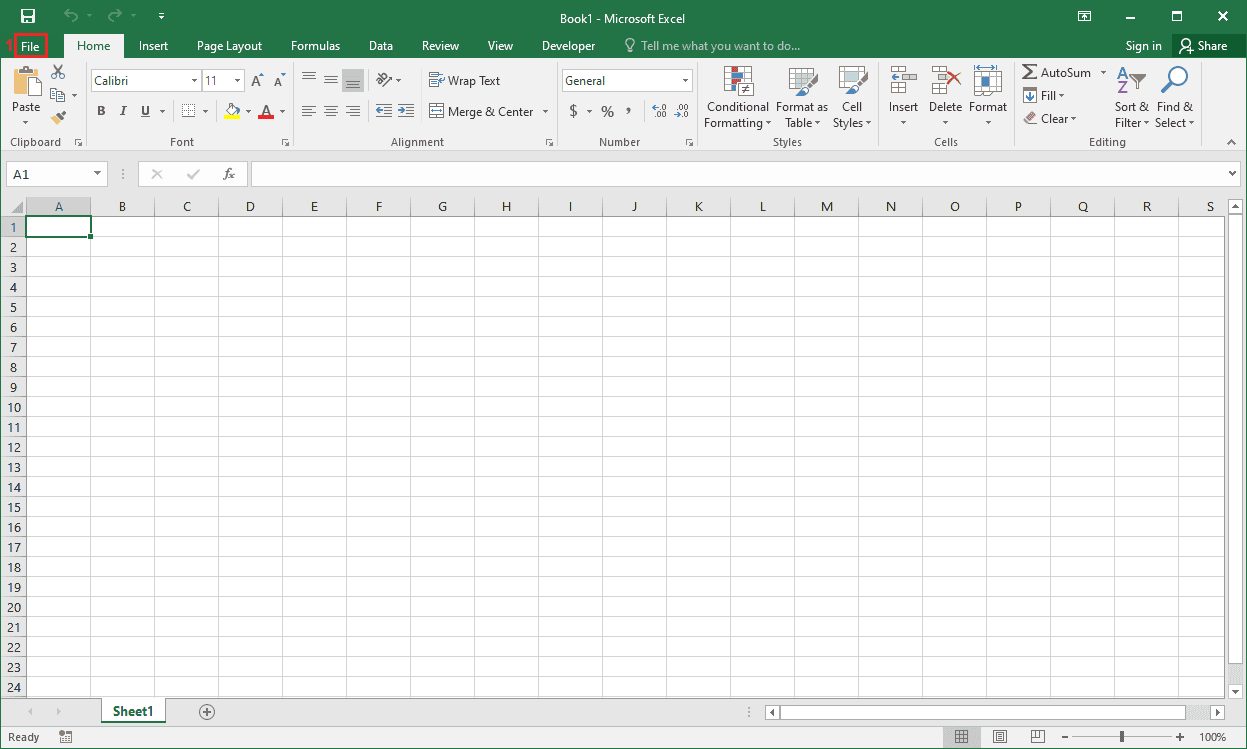
2. Click on Options (2) at the bottom of the side menu.
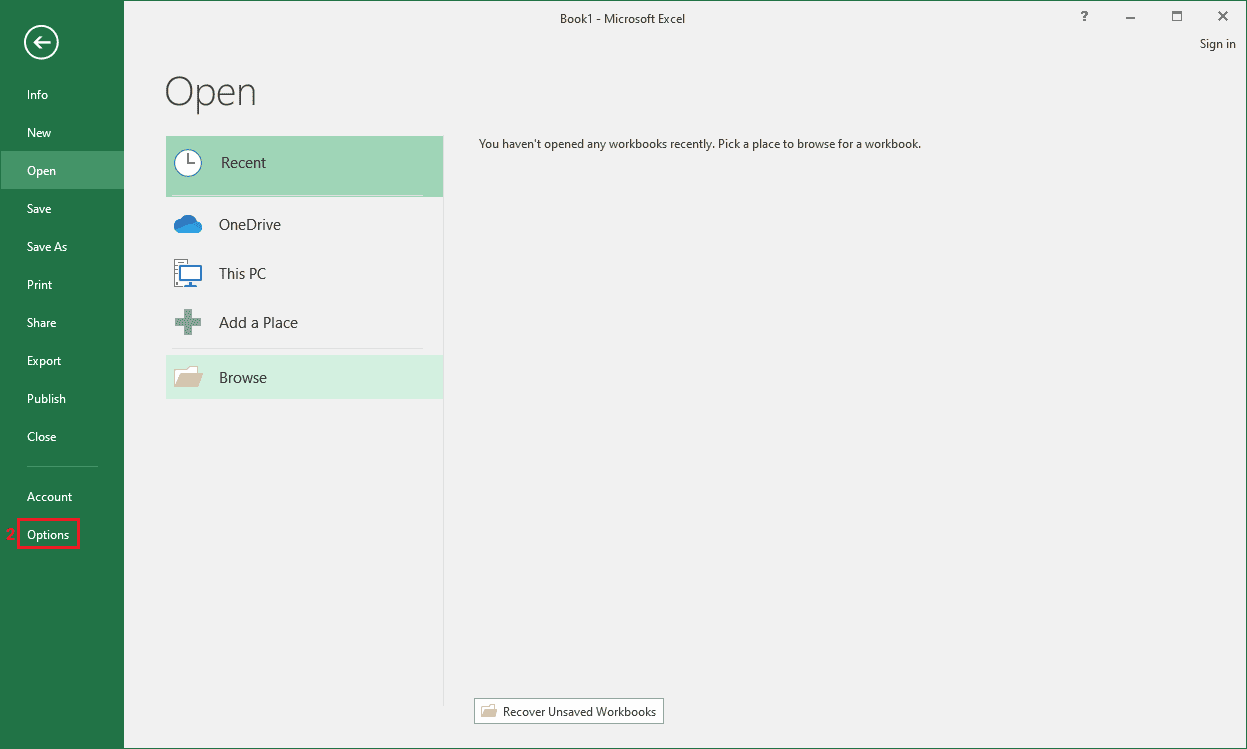
3. Click on Customize Ribbon (3) .
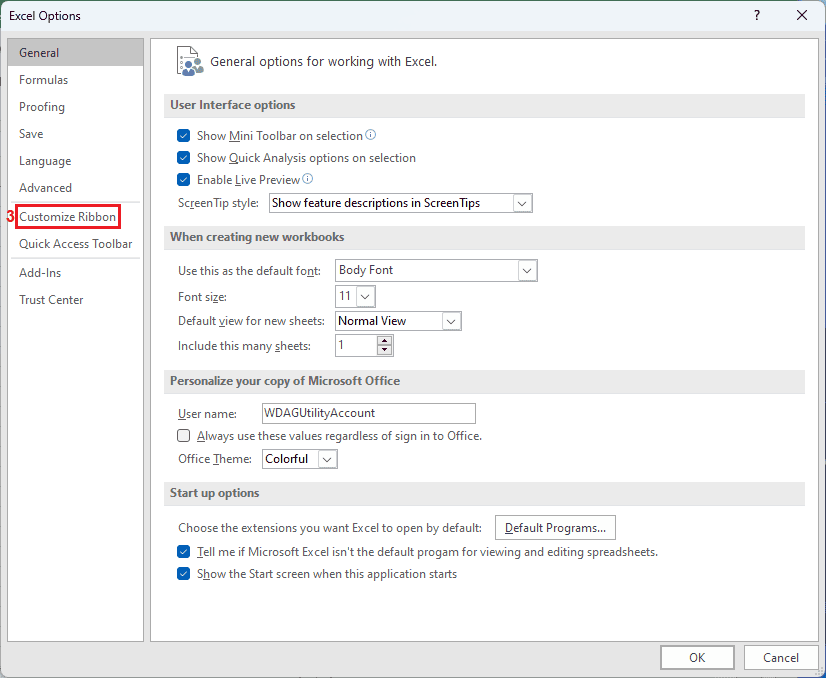
4. On the right-hand tab, scroll down to the check box Developer (4) and check it.
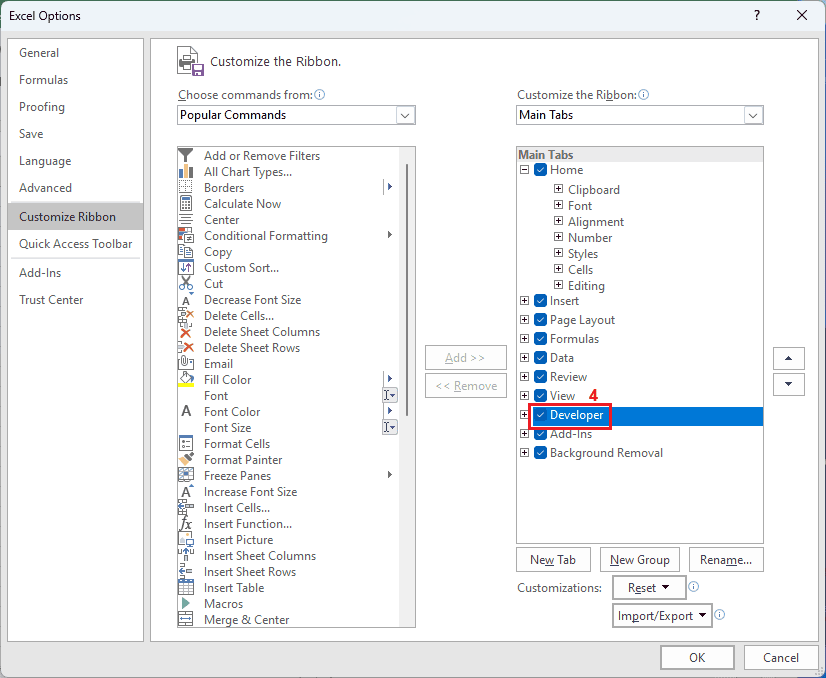
5. Click OK (5) .
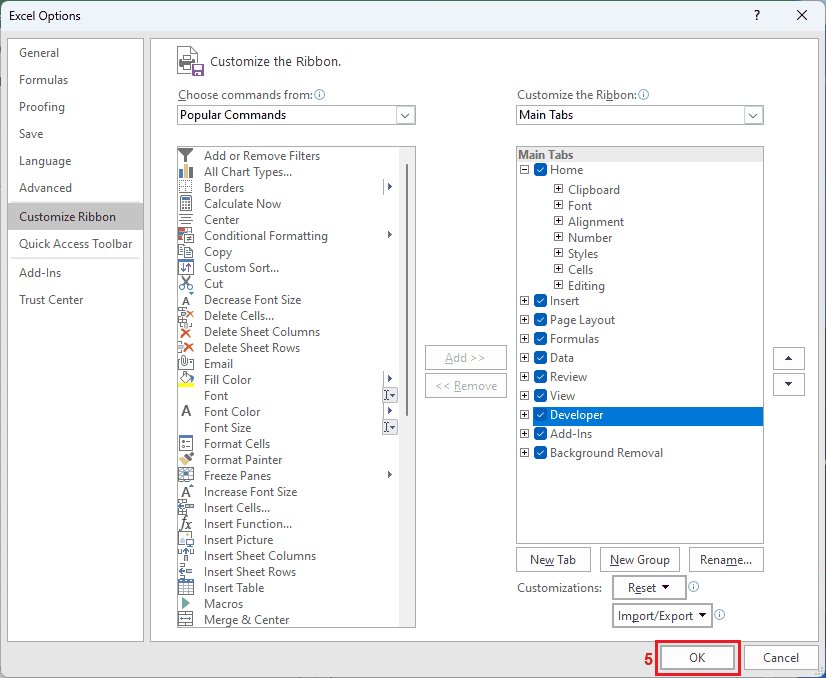
A new menu will appear at the ribbon (top part of the Excel file), called “Developer”. While you can do a lot of things with the Developer menu, we’ll be using it to build our VBA web scraping script.
Once you open up the ribbon, there’ll be a Visual Basic button visible at the top left. Click on it to open to start using VBA.
Clicking on the button will open a completely new window. That’s your development environment for VBA web scraping. Like with any programming language, there’s some preparatory work for every project.
First, we’ll need to import references (libraries, packages, or modules in other programming languages) to get the necessary functions for our Excel web scraping tool.
Click on Tools and then on References . Click the checkmark on these two libraries: Microsoft HTML Object Library and Microsoft Internet Controls . Finally, click OK . Note that you can press M on your keyboard to instantly scroll down to the first reference that starts with an “M”.
Basic Concepts of VBA Web Scraping
The two references you’ve imported are the tools we’ll need to visit web pages and to scrape data from them. HTML object library allows VBA to interact with HTML files in various ways such as selecting the entire document or a part of it.
Microsoft Internet Controls, on the other hand, gives you access to Internet Explorer. While it’s certainly not the most efficient browser, you get full control over automating Internet Explorer, such as creating instances, visiting URLs, and interacting with elements.
Both of these references are vital to Excel web scraping. You wouldn’t be able to perform data extraction without them as there would be no way to visit URLs or interact with HTML.
We’ll also get two opportunities to scrape data. Our references allow us to automate Internet Explorer, which is better for more complicated websites. There’s also the XMLHTTP module (akin to Python Requests library ), which can send HTTP requests directly to websites without creating a browser instance.
How to Write Your First VBA Web Scraper
Head back to your Excel spreadsheet and create a new tab while giving a name (“Test” works fine). It should now appear in the VBA screen as “SheetX (Test)”.
Right click on your sheet, select Insert and click on Module . That should open a new window that’s akin to a programming interface in other IDEs. Now we can begin writing code.
We’ll start by creating a script that uses Internet Explorer to visit a website and download the HTML.
Sub ScrapeWebsiteUsingIE()
' Declare a variable to hold the Internet Explorer application object
Dim ie As Object
' Create an instance of Internet Explorer
Set ie = CreateObject("InternetExplorer.Application")
' Make the Internet Explorer window invisible (set to True if you want to see the browser)
ie.Visible = False
' Navigate to the specified URL
ie.navigate "http://iproyal.com"
' Wait for the browser to complete the loading of the web page
Do While ie.Busy Or ie.readyState <> 4
' DoEvents allows the operating system to process other events while waiting
DoEvents
Loop
' Declare a variable to hold the HTML document object
Dim html As Object
' Set the HTML document object to the current document in Internet Explorer
Set html = ie.document
' Declare a variable to hold the specific element we want to extract data from
Dim element As Object
' Find the HTML element by its ClassName (change text in parentheses to the actual class name of the element you want)
Set element = html.getElementsByClassName("mt-16 sm:mt-24 text-center lg:text-left tp-headline-m lg:tp-headline-xl")
' Reference the active sheet
Set ws = ThisWorkbook.Sheets("Test") ' Adjust as necessary if you want a specific sheet
' Set starting row
Dim startRow As Integer
startRow = 1
' Check if any elements were found
If element.Length > 0 Then
Dim i As Integer
For i = 0 To element.Length - 1
' Check if the element supports innerText property
On Error Resume Next
Dim elementText As String
elementText = element.Item(i).innerText
If Err.Number <> 0 Then
Err.Clear
' Try another property if innerText fails
elementText = element.Item(i).outerText
End If
On Error GoTo 0
' Output the inner text of each element if it was successfully retrieved
If elementText <> "" Then
Worksheets("Test").Cells(startRow, 1).Value = elementText
startRow = startRow + 1 ' Move to the next row
Else
ws.Cells(startRow, 1).Value = "Element does not support innerText or outerText."
startRow = startRow + 1 ' Move to the next row
End If
Next i
Else
ws.Cells(startRow, 1).Value = "No elements found with the specified class name."
End If
' Quit the Internet Explorer application
ie.Quit
' Release the Internet Explorer object
Set ie = Nothing
End Sub
While the comments are mostly self-explanatory, here’s a quick rundown of the process our VBA code for web scraping goes through:
- We create an object that holds a headless Internet Explorer instance.
- Our IE instance heads over to the specified URL and waits until loading is complete.
- We then create an object that stores the HTML file and create an element object where we’ll store specific data. We find that specific data by searching the HTML file for a specific class name.
- Since we’ll want to output the data to our worksheet, we create an integer value for a starting row. That way we can increment it later on if there’s more than one data point.
- We then create a loop if more than one element is found in order to extract all of the data in sequence.
- Anything that’s found is turned into a string. Additionally, we use both innertext (only the textual information without HTML code) and outertext (both textual and HTML code information) to look through the element.
- Finally, we check if our element is not empty. If it’s not, we output the first value found and increment our startRow integer.
- After that, we quit Internet Explorer and the code itself.
Once the web scraping script is complete, you should get the H1 heading from IPRoyal’s homepage output into your first Excel row and column.
Using XMLHTTP for HTTP Requests
Instead of using Internet Explorer to perform Excel web scraping, we can send HTTP requests directly to the website. Doing so is often much faster and efficient, however, it also gets blocked more frequently, so it’s a trade-off.
Sub ScrapeWebsiteUsingServerXMLHTTP()
' Declare a variable to hold the ServerXMLHTTP object
Dim xml As Object
Set xml = CreateObject("MSXML2.ServerXMLHTTP.6.0")
' Make an HTTP GET request to the specified URL
xml.Open "GET", "http://iproyal.com", False
xml.send
' Wait for the request to complete
Do While xml.readyState <> 4
DoEvents
Loop
' Check if the request was successful
If xml.Status = 200 Then
' Create an HTMLDocument object to parse the response
Dim html As Object
Set html = CreateObject("HTMLFile")
html.body.innerHTML = xml.responseText
' Declare a variable to hold the specific elements we want to extract data from
Dim elements As Object
Set elements = html.getElementsByClassName("mt-16 sm:mt-24 text-center lg:text-left tp-headline-m lg:tp-headline-xl")
' Set starting row
Dim startRow As Integer
startRow = 1
' Check if any elements were found
If elements.Length > 0 Then
Dim i As Integer
For i = 0 To elements.Length - 1
' Check if the element supports innerText property
On Error Resume Next
Dim elementText As String
elementText = elements.Item(i).innerText
If Err.Number <> 0 Then
Err.Clear
' Try another property if innerText fails
elementText = elements.Item(i).outerText
End If
On Error GoTo 0
' Output the inner text of each element if it was successfully retrieved
If elementText <> "" Then
Cells(startRow, 1).Value = elementText
startRow = startRow + 1 ' Move to the next row
Else
Cells(startRow, 1).Value = "Element does not support innerText or outerText."
startRow = startRow + 1 ' Move to the next row
End If
Next i
Else
Cells(startRow, 1).Value = "No elements found with the specified class name."
End If
Else
MsgBox "Failed to retrieve the web page. Status: " & xml.Status
End If
' Clean up
Set xml = Nothing
End Sub
Most of the VBA code for web scraping remains nearly identical with the exception of sending the request. Instead of creating an Internet Explorer instance, we create a ServerXMLHTTP object to send a GET request to our URL. To avoid any errors, we check for a successful response and then store the text of the HTML file into an object.
Advanced Techniques in VBA Web Scraping
Using VBA isn’t limited to just the inbuilt references. Just like with any other programming language, you can find third-party references that’ll allow you to greatly expand upon VBA web scraping capabilities.
One such popular option is integrating Selenium into your VBA web scraping project. Selenium allows you to automate more efficient and popular browsers such as Chrome and Firefox. You’ll need to download install SeleniumBasic , and find the appropriate web drivers to get Selenium running on your VBA web scraping project.
Another common issue you’ll run into is dynamic content. Luckily, VBA can handle these issues rather easily. We’ve actually used one of the functions DoEvents in our VBA web scraping scripts – using loops and DoEvents allows you to wait for pages to fully load. Include interactions that would load more dynamic content, and you’re done.
Finally, you can also parse data using VBA. In fact, it’s rather handy as it includes both web scraping and parsing features within the programming language. You can also do some parsing within the Excel file itself.
There are plenty of VBA web scraping and parsing functions you can use. Some of the popular options are getElementsByTagName, getElementById, and getElementsByClassName. Each of these lets you parse the HTML file and find specific elements. Using innerText or outerText can also provide you with more customization options when using VBA for web scraping.
Conclusion
VBA web scraping can be incredibly useful as it automatically combines web scraping, parsing, and data analysis capabilities into one singular package. While VBA web scraping isn’t as popular, it’s a good option for smaller projects or smaller teams.
Additionally, it’s fully supported and built into the Microsoft ecosystem, so there are plenty of other integrations and capabilities. So, learning VBA web scraping is definitely a good option for nearly anyone. The only drawback is that VBA web scraping requires you to learn a programming language that is less used and supported.


